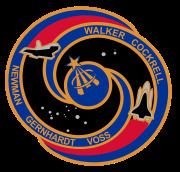Mission type Research SATCAT no. 23667 Period 1.5 hours Launch date 7 September 1995 Landing date 18 September 1995 | COSPAR ID 1995-048A Orbits completed 171 Apogee 321,000 m Dates 7 Sep 1995 – 18 Sep 1995 | |
 | ||
Mission duration 10 days, 20 hours, 29 minutes, 56 seconds Distance travelled 7,200,000 kilometres (4,500,000 mi) Members | ||
Space shuttle flight 71 sts 69 post flight presentation
STS-69 was a Space Shuttle Endeavour mission, and the second flight of the Wake Shield Facility (WSF). The mission launched from Kennedy Space Center, Florida on 7 September 1995. It was the 100th successful manned NASA spaceflight, not including X-15 flights.
Contents
Spacewalks
Mission highlights
The 11-day mission was the second flight of the Wake Shield Facility (WSF), a saucer-shaped satellite that was to fly free of the Shuttle for several days. The purpose of the WSF was to grow thin films in a near perfect vacuum created by the wake of the satellite as it moved through space. The crew also deployed and retrieved the Spartan 201 astronomy satellite, performed a six-hour spacewalk to test assembly techniques for the international Space Station and tested thermal improvements made to spacesuits used during space walks.
The Spartan 201 free-flyer made its third flight aboard the Shuttle. The Spartan 201 mission was a scientific research effort aimed at the investigation of the interaction between the Sun and its outflowing wind of charged particles. Spartan's goal was to study the outer atmosphere of the Sun and its transition into the solar wind that constantly flows past the Earth.
STS-69 saw the first flight of the International Extreme Ultraviolet Hitchhiker (IEH-1), the first of five planned flights to measure and monitor long-term variations in the magnitude of absolute extreme ultraviolet (EUV) flux coming from the Sun, and to study EUV emissions from the plasma torus system around Jupiter originating from its moon Io.
Also aboard Endeavour were the combined Capillary Pumped Loop-2/Gas Bridge Assembly (CAPL-2/GBA) payload. This experiment consisted of the CAPL-2 Hitchhiker payload designed as an in-orbit microgravity demonstration of a cooling system planned for the Earth Observing System Program and the Thermal Energy Storage-2 payload, part of an effort to develop advanced energy generation techniques. Also a part of this payload were several Get Away Special (GAS) experiments which investigated areas such as the interaction of spacecraft attitude and orbit control systems with spacecraft structures, fluid-filled beams as structural dampers in space and the effects of smoldering combustion in a long-term microgravity environment.
Another payload flown with a connection to the development of the Space Station was the Electrolysis Performance Improvement Concept Study (EPICS). Supply of oxygen and hydrogen by electrolyzing water in space plays an important role in meeting NASA's needs and goals for future space missions. On-board generation of oxygen was expected to reduce the annual resupply requirement for the Space Station by approximately 5,400 kilograms (11,900 lb).
Other payloads aboard were the National Institutes of Health- Cells-4 (NIH-C4) experiment that investigates bone loss during space flight; the Biological Research in Canister-6 (BRIC-6) that studies the gravity-sensing mechanism within mammalian cells. Also flying were two commercial experiments. (CMIX-4) whose objectives included analysis of cell change in microgravity along with studies of neuro-muscular development disorders and the Commercial Generic Bioprocessing Apparatus-7 (CGBA-7). CGBA was a secondary payload that served as an incubator and data collection point for experiments in pharmaceuticals testing and biomedicine, bioprocessing and biotechnology, agriculture and the environment.
The Thermal Energy Storage (TES-2) experiment was also part of the CAPL-2/GBA-6. The TES-2 payload was designed to provide data for understanding the long-duration behavior of thermal energy storage fluoride salts that undergo repeated melting and freezing in microgravity. The TES-2 payload was designed to study the microgravity behavior of voids in lithium fluoride–calcium fluoride eutectic, a thermal energy storage salt. Data from this experiment would validate a computer code called TESSIM, useful for the analysis of heat receivers in advanced solar dynamic power system designs.
